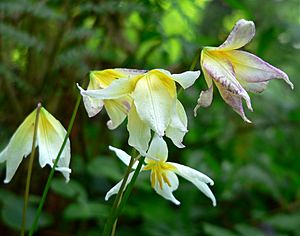Pacific fawn lily facts for kids
Quick facts for kids Pacific fawn lily |
|
|---|---|
 |
|
| Scientific classification | |
| Genus: |
Erythronium
|
| Species: |
helenae
|
The St. Helena fawn lily (Erythronium helenae) is a beautiful flowering plant. It belongs to the lily family. People also call it the Pacific fawn lily. This special plant is found only in a small area of California.
About the St. Helena Fawn Lily
The St. Helena fawn lily gets its name from Mount Saint Helena. This mountain is in the coastal areas north of the San Francisco Bay Area. It's a unique spot where three counties meet: Napa, Sonoma, and Lake Counties.
Where It Grows
This plant is endemic to California. This means it grows naturally only in this specific region. You can find it on the slopes of Mount Saint Helena. It usually grows at heights between 500 and 1200 meters (about 1,600 to 3,900 feet). It often grows in a special type of ground called serpentine soils.
What It Looks Like
The St. Helena fawn lily grows from a bulb. This bulb is usually 3 to 5 centimeters (about 1 to 2 inches) wide. Each plant has two wide leaves. These leaves can be up to 20 centimeters (about 8 inches) long. They are green and often have spots of brown or white.
The plant also produces tall, straight stalks. These stalks can grow up to 30 centimeters (about 12 inches) high. Each stalk usually has one to three flowers on it.
Its Flowers
The flowers of the St. Helena fawn lily are very pretty. They have white tepals. Tepals are like petals and sepals combined. The tepals are about 3 or 4 centimeters (about 1.2 to 1.6 inches) long. Their bases are yellowish.
As the flowers get older, their white tepals change. They can develop pink or purple streaks or spots. The flowers also have yellow stamens. Stamens are the parts of the flower that produce pollen. They have large yellow anthers, which hold the pollen.
See also
 In Spanish: Erythronium helenae para niños
In Spanish: Erythronium helenae para niños

